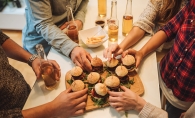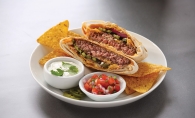Nothing says summer more than a backyard barbecue, and in Minnesota we have to take advantage of every nice day we get. While many of us heat up the grill, there are a few Woodbury residents who will be pulling out a different piece of equipment. It’s big, it’s green, and it’s shaped like an egg.
It’s the Big Green Egg, a kamado-style cooker modeled after cookers used in ancient China and Japan. It is made with inch-thick ceramic, heated with standard charcoal and is extremely versatile, for grilling, smoking, roasting and baking. And local residents—and friends—Jake Gulden and Eric Lavine swear by it.
History of the Big Green Egg
It’s based off a centuries-old method of cooking used during the Chinese Qin Dynasty, and in third century Japan. Entrepreneur and American serviceman Ed Fisher discovered the domed clay cooker when working overseas and brought the idea home. In 1974, the Big Green Egg store opened in Atlanta, and sold the cooking device, then made with clay. After a few years, the design was improved to be less fragile, eventually using the tough ceramic found today.
“I got it as a gift for Father’s Day in 2010,” Gulden says. “And I’ve been using it ever since.” A friend of his had one, and the seed was planted in Gulden. “As far as the type of food it puts out, it’s second to none,” he says. “The beauty of it is, it’s hard to screw up. Overcooking food on something like that is a little more difficult than on your standard grill just because it holds all the moisture in.”
For Lavine, his passion for grilling and smoking food goes back a little further. He and some of his buddies would go up north every winter to play boot hockey for a weekend; a friend would bring along his 400-pound smoker. “We’d bring a trailer just for that; I would tend to the smoker because I liked how it smelled,” he says. So for his birthday six years ago, his wife got him the Big Green Egg, which is decidedly more manageable in both size and upkeep.
While Gulden and Lavine both have the same piece of equipment, their culinary specialties differ. Gulden’s go-to is pork butt, or the shoulder cut of the pig. “We throw a pretty good neighborhood party at the end of the summer [when] I normally cook anywhere from 20 to 25 pounds of pork butt,” Gulden says. Depending on the size, he says, he cooks the meat anywhere from 12 to 26 hours. And the benefit of the Egg is that once the temperature is set, he doesn’t need to add more coals, partly because it’s burning low and slow, which also adds to the flavor. “You get the flavor of the charcoal. The smoky aspect of it,” he says. He likes that smoky aspect for roast chicken as well, but he has yet to attempt ribs or brisket. “That’s kind of on the agenda.”
In general, Gulden uses his Egg for items that need to cook longer. “I don’t do burgers on it unless I’m looking to get a certain type of flavor on it,” he says. But it can be done: “[The Egg] can be used as a slow smoker, your standard grill, even an oven,” Gulden says, adding that pizza in the Egg turns out great.
The two things Gulden hasn’t tried—ribs and brisket—are the two things Lavine is known for. For the brisket, Lavine says, “The main thing you need to do is get a really good rub.” Oftentimes, this is a personal preference. Some are sweeter, some are spicy. “Go to the store, buy a few rubs, and taste them,” he says. Or make your own.
Lavine found his favorite rub through a Food Network show: Mike’s Magic Rub from 17th Street Barbecue in St. Louis, Missouri. But it was very expensive, and they don’t just hand out the recipe. “I read the ingredients, went to Sam’s Club and bought a huge jar of everything and started experimenting and made my own,” Lavine says. You can do your own experiments, but he also says any rub found at a grocery store will do just fine.
Lavine puts his rub on the brisket the night before and lets it sit in a very large sealed container overnight in the refrigerator. He takes it out of the fridge an hour before cooking, “because if it’s cold in the middle, it cooks too quickly elsewhere,” and then cooks it low and slow for 8-10 hours, depending on the size. Halfway through, he wraps it loosely in foil, a trick he learned from watching a barbecue show with Food Network’s Bobby Flay.
Depending on who he’s cooking for, Lavine might add another trick too. “People like to have burnt ends, so if I cut the brisket in half: instead of two burnt ends, I get four,” he says.
For his ribs, Lavine buys the extra meaty ones, puts the rub on the night before, refrigerates and puts them on for around five hours. Again, he says, the rub you use is key. And he should know, since he’s a Certified Kansas City Barbecue Judge.
One might wonder how a Minnesotan becomes an expert in Kansas City barbecue. It’s the same question Lavine asked back when he was the head tour guide at Summit Brewing in St. Paul. Through that volunteer job he met many people, and one of them “said he was a KCBS [Kansas City Barbecue Society] certified judge.” Turns out, it’s a class, an oath, and a payment. So Lavine jumped right in.
“Sam’s Club, here in Woodbury, has a huge [barbecue competition] event the last Saturday in July [for the past several years],” and Lavine goes every year. Events are held in other parts of the state as well, but the drive makes it hard to manage. “But I can drive five minutes to Sam’s, and eat meat all day long and tell people what I think of it,” he says.
At the event, there are competitions for chicken, then ribs, pork and brisket. “You’re judging on appearance, taste and texture,” he says. So it’s safe to say Lavine knows his barbecue.
That’s partly how Lavine and Gulden came to know each other. Lavine was at one of Gulden’s neighborhood parties where he made the pork butt. “We were just getting to know each other—we have kids in the same grade,” Gulden says. “He was eating [the pork] like a judge. He told me, ‘This is fantastic barbecue!’ And I said, ‘Oh thanks,’ and he was like, ‘No I mean it, I’m a certified [judge],’” Gulden recalls. “That’s when you kind of go, ‘Oh, I guess this means something!’”
Gulden’s pork butt is the hit of the neighborhood, and with the Egg it’s easy and fairly inexpensive. “For feeding crowds, I’m a little frugal,” he says. “It’s relatively inexpensive to feed a crowd with a pork butt from Costco. From that standpoint, being able to spread that out into sandwiches for people, it’s massive.”
“I enjoy [eating],” Gulden says, when asked why he loves the Egg—that and it’s easy once you get the hang of it. For Lavine, the answer is similar. “It gets me out of the house,” Lavine says. “I tend to it kind of all day. Drink beer, hang out, kids run around the backyard, it smells amazing, the food is good. It’s rewarding. It’s satisfying.”
Eric Lavine's Brisket Recipe:
The night before cooking, make cuts on the fatty side (top) of the brisket in a criss-cross pattern and massage the rub into the fat, getting it close to the meat. Add rub to the bottom of the brisket as well. Seal overnight in the fridge in a plastic container.
Remove from fridge an hour before cooking to bring to room temperature.
Heat the Big Green Egg to 220 degrees, and add the brisket.
Around hour 4 or 5, wrap it lightly in foil, or create a foil boat, to catch drippings and keep in moisture. Do not use a heavy foil pan, as it’s too thick.
After 8-10 hours, depending on size, remove from the grill. Let sit before slicing.
Enjoy!
Jake Gulden’s Pork Butt
Ingredients:
- Pork Butt (shoulder)
- Favorite rub or seasoning blend of your choosing
- Yellow Mustard
- Apple Juice/Apple Cider
Big Green Egg Prep:
Fill
your egg with charcoal and light it (feel free to add any of your
favorite wood chips for additional smoke flavor). Set the plate setter
“feet up.” Place a standard-sized tin foil pan on the plate setter
between the feet. Fill the pan a quarter way up with either apple cider
or apple juice. This tray will double as a drip pan, as well as add
additional moisture while cooking. Set the grill grate on top of the
plate setter, and bring the egg to temp at 220-225 degrees.
Ingredient Prep:
Cover
entire pork butt with yellow mustard (this gives no flavor; it simply
gives the rub a surface to stick to.) Generously cover entire pork butt
with your favorite rub.
Set the pork on the grill grate with your
temperature probe inserted into the thickest part of the meat, and
close the lid. Leave it on the grill at 220-225 degrees until the
internal temperature reaches 190 degrees. Cooking times will vary
depending on the size of your pork butt. Once the temperature reaches
190 degrees, remove the meat and immediately wrap it in aluminum foil.
The temperature will continue to climb approximately five degrees or so
once removed. Let the foiled meat rest for a half hour minimum. *I like
to wrap mine in heavy aluminum foil and let it rest in a small (un-iced)
cooler for about an hour. The cooler ensures that the meat doesn’t cool
too much prior to shredding and serving.
Shred with forks or
bear claws, and serve however you see fit. You can’t go wrong with
carnitas, or the standard pulled pork sandwich, topped with homemade
coleslaw and barbecue sauce.









